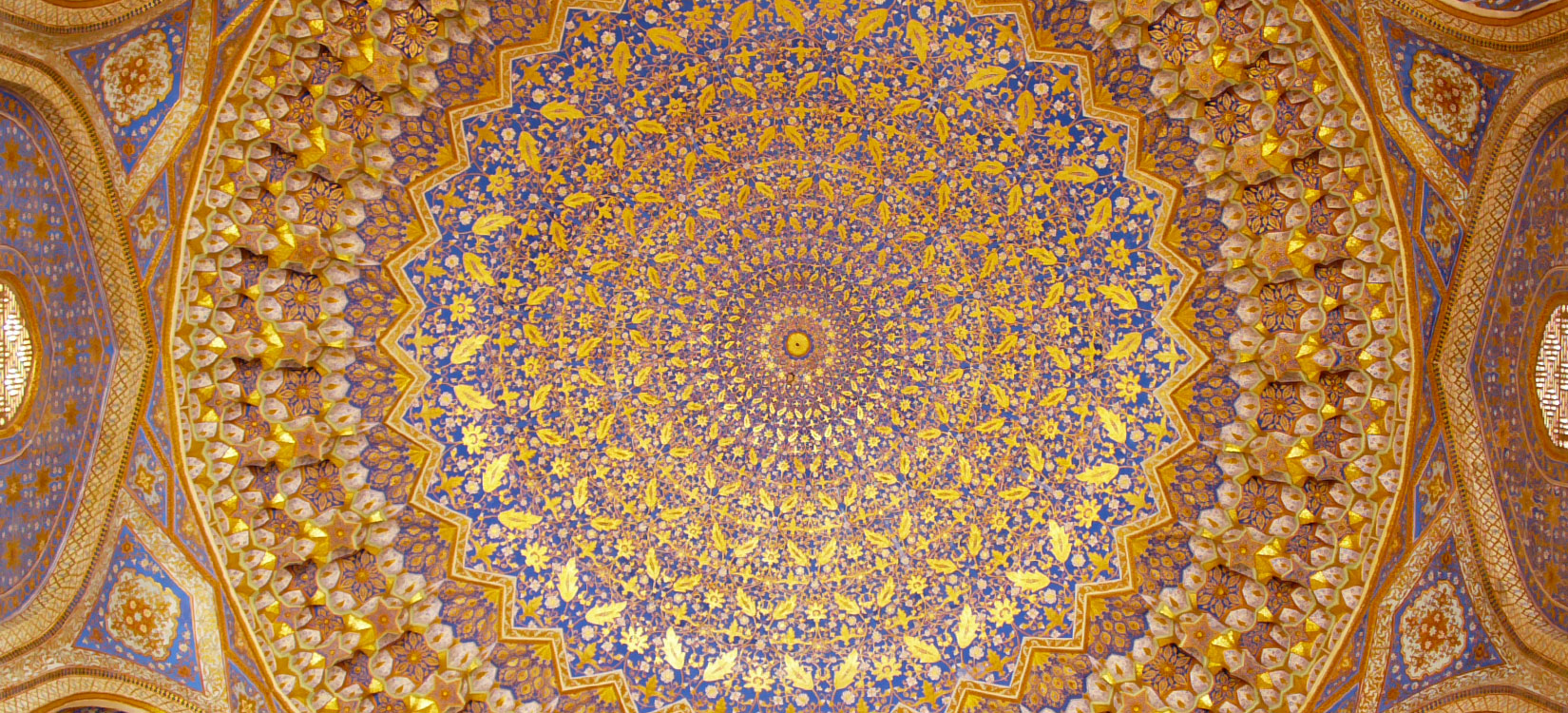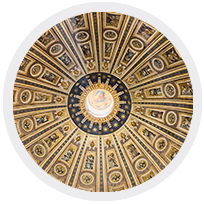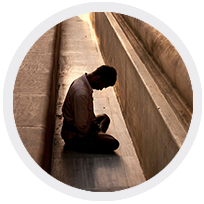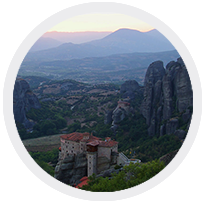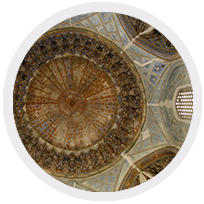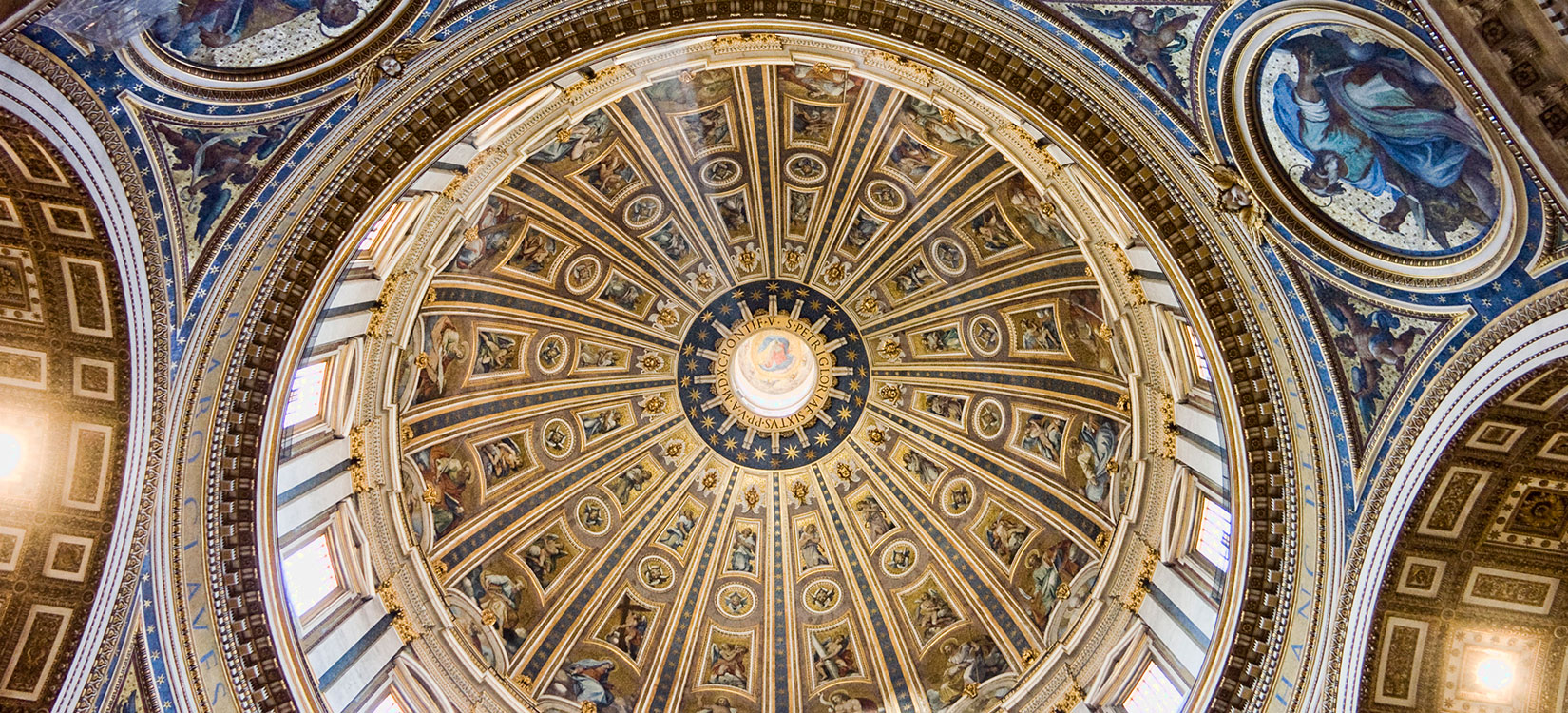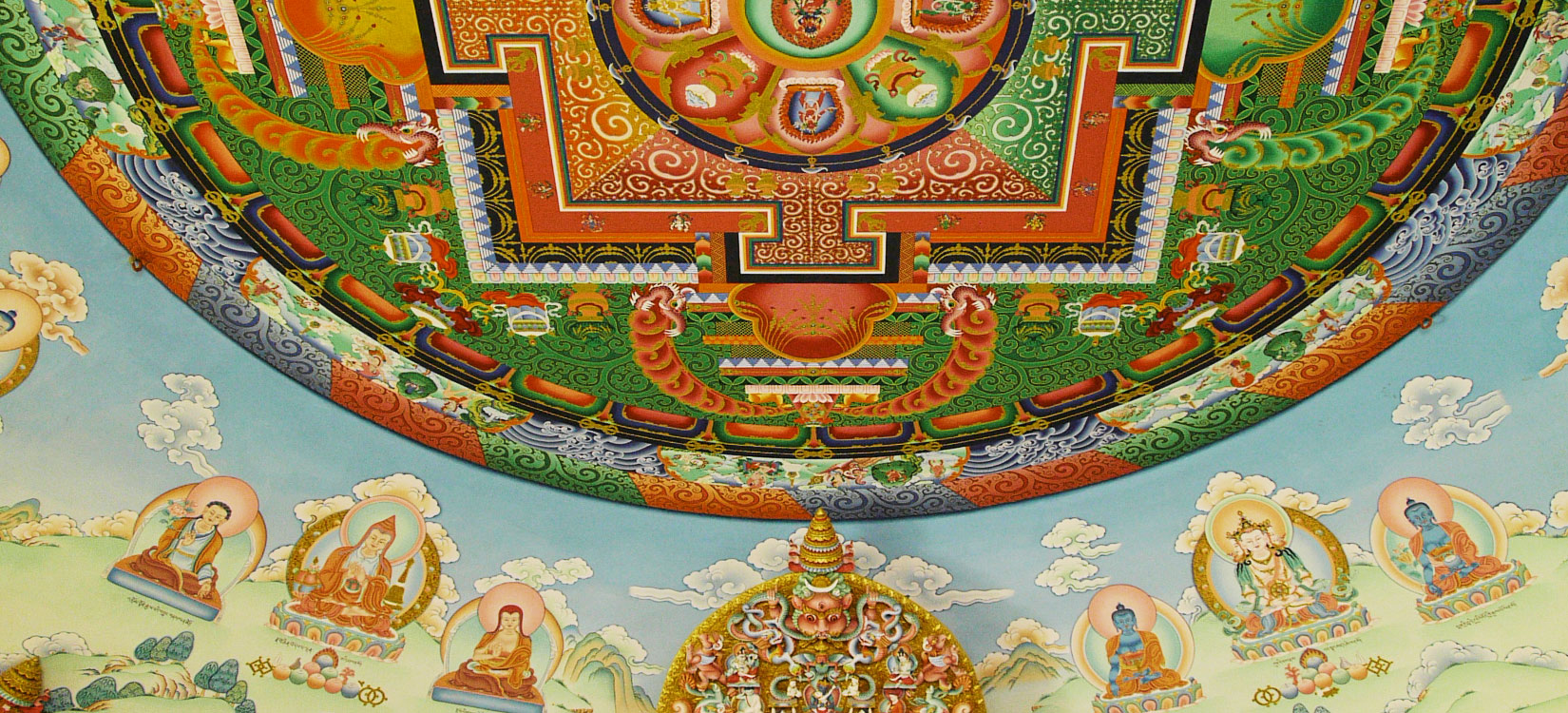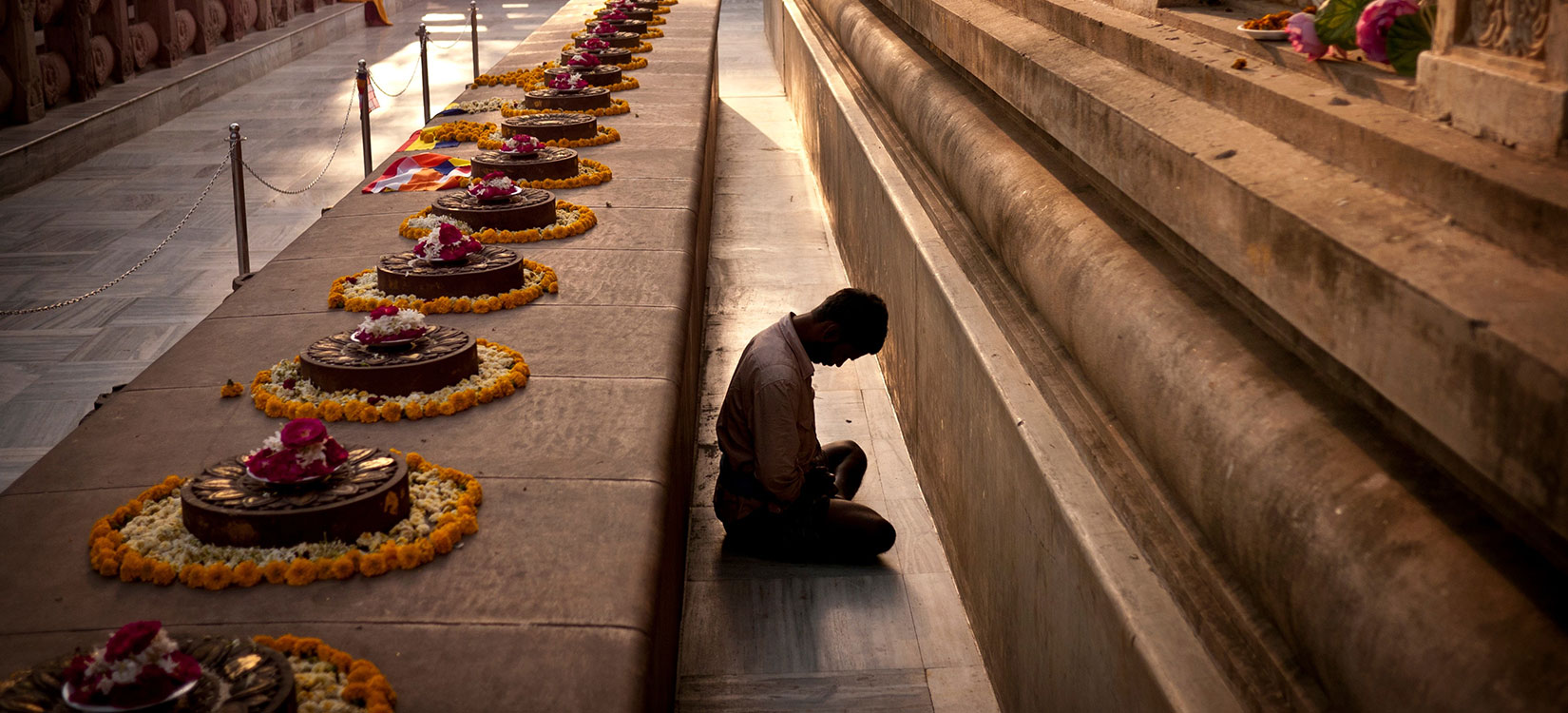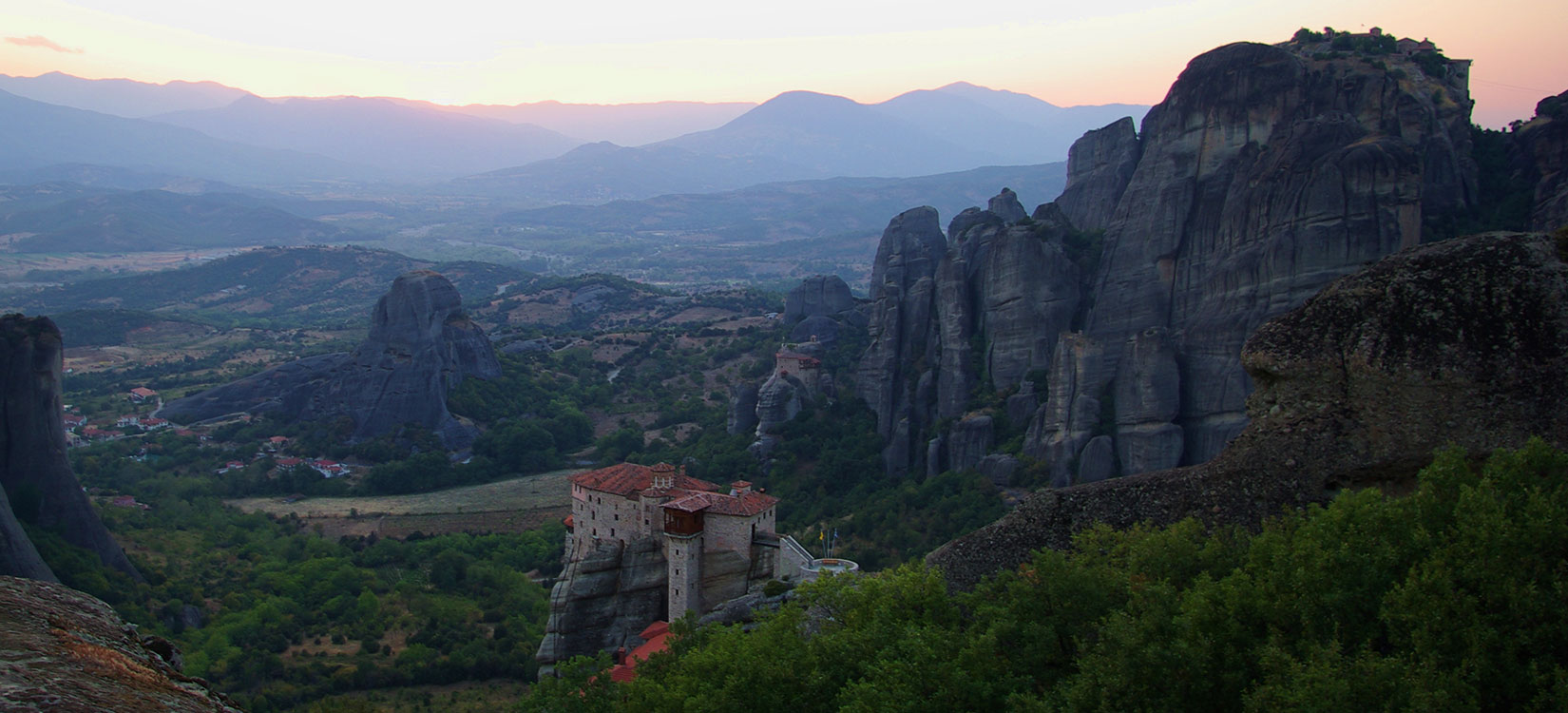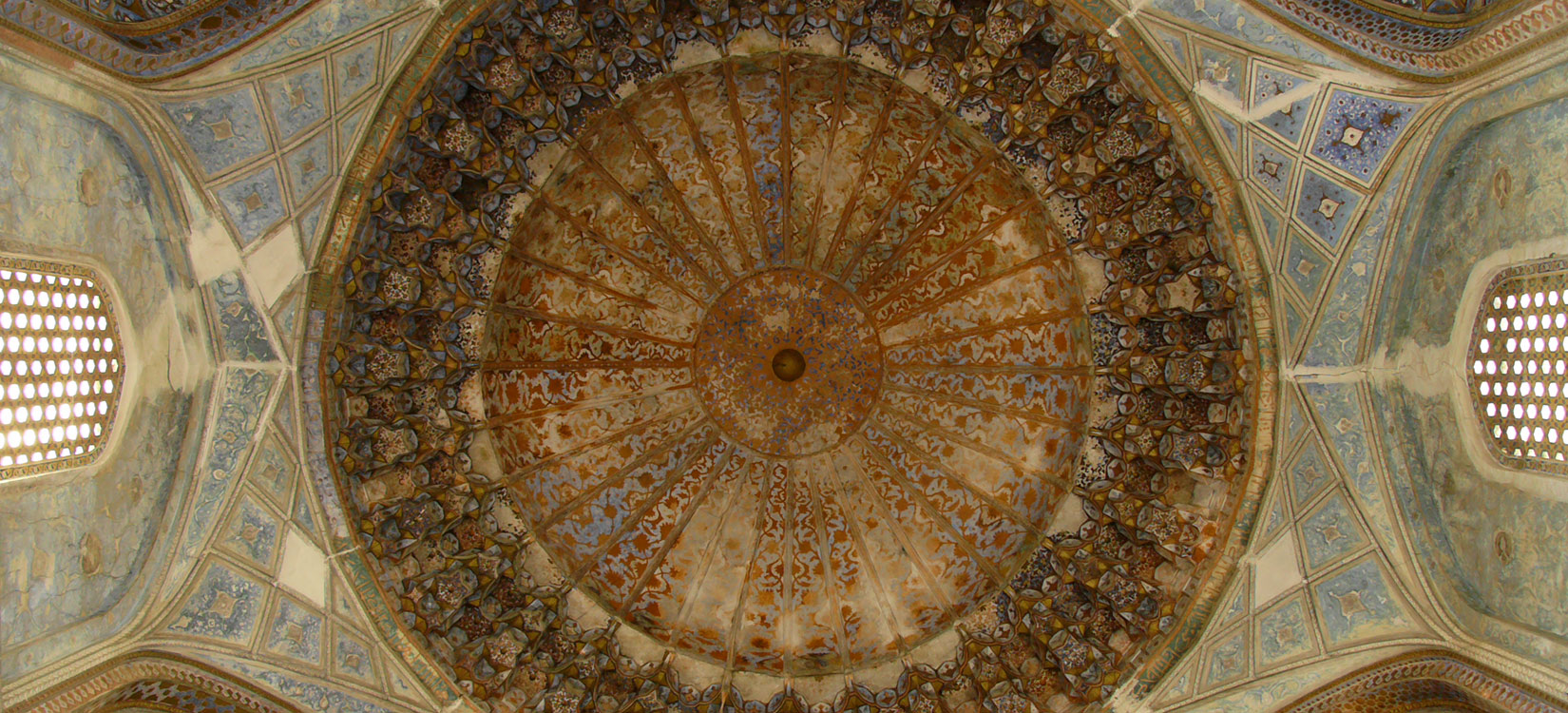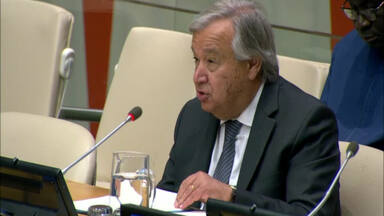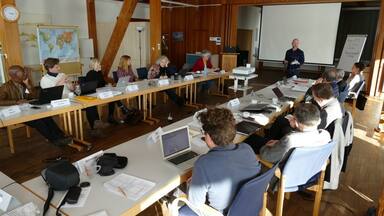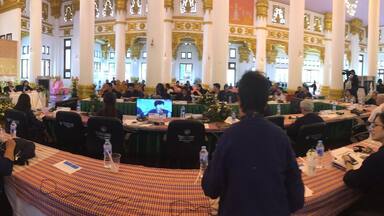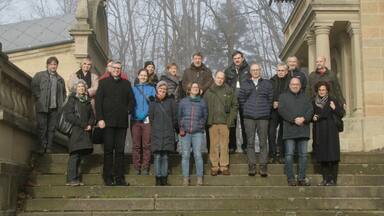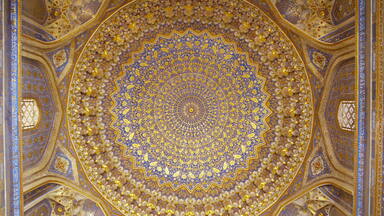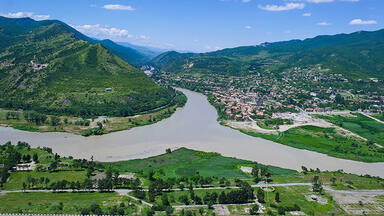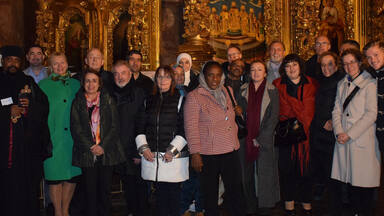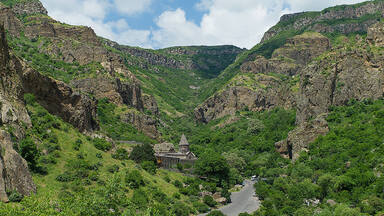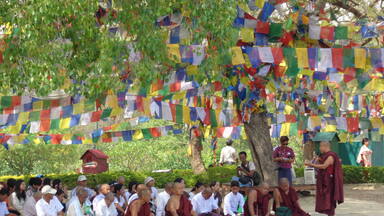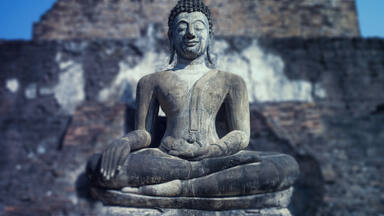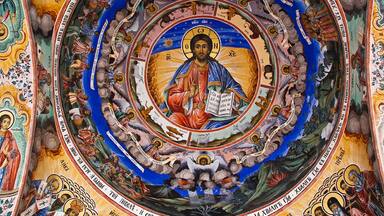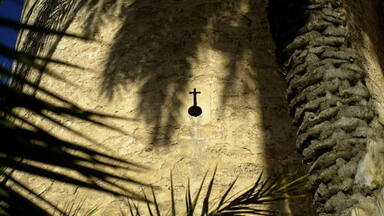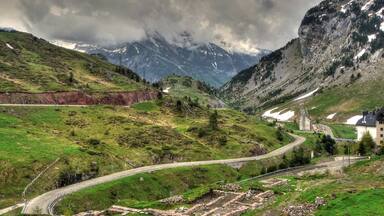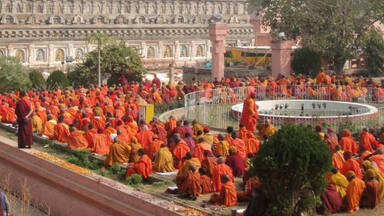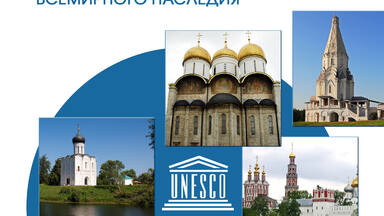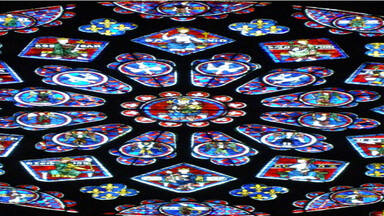There exist a great variety of religious and sacred sites that are representative of the different cultures and traditions of the world. Approximately 20 percent of the properties inscribed on the World Heritage List have some sort of religious or spiritual connection.
These properties to be found in most countries around the world constitute the largest single category on the List. Specific and significant spiritual meanings are mentioned to justify the Outstanding Universal Value of a large number of the World Heritage properties. Numerous historic cities on the List possess components of religious significance and are recognized as holy cities by different communities.
History and terminology
"As cultures encompass lifestyles, different ways of living together, value systems, traditions and beliefs, the protection and promotion of their rich diversity invite us to rise to new challenges at the local, national and international levels. This will involve integrating the principles of dialogue and mutual knowledge in all policies, particularly education, science, culture and communication policies, in the hope of correcting flawed cultural representations, values and stereotypes."
2010 United Nations International Year for the Rapprochement of Cultures
In recent years UNESCO played a leading role in the development and promotion of a powerful normative action related to the protection of cultural and natural heritage in all its forms.
A corpus of standard-setting documents, including charters and recommendations, exists on the subject of monuments and sites. A number of research studies and analyses of religious heritage and sacred sites were carried out by the Advisory Bodies - ICCROM, ICOMOS and IUCN. There were a number of conclusions and recommendations drawn from previous meetings and activities on religious and sacred heritage, such as the ICCROM 2003 Forum on the conservation of Living Religious Heritage, the 2005 ICOMOS General Assembly resolution calling for the "establishment of an International Thematic Programme for Religious Heritage", and 2011 ICOMOS General Assembly Resolution on Protection and enhancement of sacred heritage sites, buildings and landscapes, as well as the UNESCO MAB/IUCN Guidelines for the Conservation and Management of Sacred Natural Sites.
Several recommendations directly or indirectly concern the safeguarding of the spirit of place, namely their living, social and spiritual nature, in particular the Nara Document on Authenticity adopted at the Nara Conference on Authenticity in relation to the World Heritage Convention held in 1994 and the Quebec Declaration on the Preservation of the Spirit of Place, adopted at the 16th General Assembly of ICOMOS in 2008.
The term "Religious property", as used in the ICOMOS study "Filling the Gaps - an Action Plan for the Future", defines "any form of property with religious or spiritual associations: churches, monasteries, shrines, sanctuaries, mosques, synagogues, temples, sacred landscapes, sacred groves, and other landscape features, etc.".
The term "Sacred site" embraces areas of special spiritual significance to peoples and communities; and the term of "Sacred natural site" corresponds to the areas of land or water having special spiritual significance to peoples and communities," as proposed by the UNESCO/IUCN Guidelines for the Conservation and Management of Sacred Natural Sites, 2008
According to ICCROM, living religious heritage has characteristics that distinguish it from other forms of heritage. Sacred sites, which, according to the UNESCO MAB Programme, "are indeed the oldest protected areas of the planet", and "have a vital importance for safeguarding cultural and biological diversity for present and future generations." Collectively, the religious and sacred properties capture a range of cultural and natural diversity, and each can singularly demonstrate the spirit of a particular place.
Communities
Religious communities as World Heritage stakeholders
Understanding the continuing nature of religious and sacred heritage, having the capacity to protect its authenticity and integrity, including its particular spiritual significance, and sharing the knowledge of our common history, are the three pillars necessary for building mutual respect and dialogue between communities.
Today, the international community should define the appropriate measures to preserve the values of religious and sacred places, which form the foundation of our cultures, thereby aiming to prevent any gradual loss of our traditions.
Within the context of the International Year for the Rapprochement of Cultures 2010, proclaimed by the United Nations General Assembly, an international seminar on the role of religious communities in the management of World Heritage properties was held in Kiev (Ukraine) from 2 to 5 November 2010, under the patronage of the President of Ukraine and UNESCO. For the first time in the history of the World Heritage Convention, the issue regarding the protection of religious and sacred heritage has been discussed at the international level, involving active participation of the religious authorities.
The main objective of this first major international meeting organized under the patronage of UNESCO on heritage of religious interest was to explore ways to reflect the complexity and importance of developing proper dialogue between all stakeholders for the common goal which is protection of World Heritage properties. It was noted that these World Heritage properties - especially living religious and sacred sites - require specific policies for protection and management that take into account their distinct spiritual nature as a key factor in their conservation and that such policies cannot be sustainable without in-depth consultation with the appropriate stakeholders.
The meeting considered the view that stakeholders need to work together to preserve sacred heritage while regarding the modernization and development of society in a culturally and historically sensitive manner, with a view to strengthening identity and social cohesion. Stakeholders include religious communities, made up of believers, traditional and indigenous peoples, as well as State Party authorities, professionals and experts in relevant fields, property owners, funding bodies and other interested partners.
At the closing of the Seminar, on 5 November 2010, the participants unanimously adopted the following Statement on the protection of religious properties within the framework of the World Heritage Convention. Developed in close collaboration with national authorities, international experts, site managers and representatives of religious communities, is the first and most unique document to give general recommendations on this specific issue.
The final report of the 2010 Seminar has been submitted by the World Heritage Centre within the framework of the secretariat report for consideration by the World Heritage Committee at its 35th session (UNESCO, 2011).
Statement on the Protection of Religious Properties within the Framework of the World Heritage Convention
- The main objective of the 2010 Seminar on the Role of Religious Communities in the Management of World Heritage Properties was to explore ways of establishing a dialogue between all stakeholders, and to explore possible ways of encouraging and generating mutual understanding and collaboration amongst them in the protection of religious World Heritage properties.
- The stakeholders would include religious communities, which can comprise believers, traditional and indigenous peoples, as well as States Party authorities, professionals and experts in relevant fields, property owners, funding bodies and other interested partners.
- The participants of the Seminar welcomed the International Year for the Rapprochement of Cultures, proclaimed by the United Nations General Assembly, as a valuable tool for the mutual exchange of experiences and dialogue between cultures aiming to foster respect for each other's beliefs.
They furthermore: - Recognized the role played by religious communities in the creation, maintenance, and continuous shaping of sacred places, and the custodial role played by them in caring for these as living heritage.
- Reaffirmed the vital further role of religious communities in conveying, expressing and sustaining spiritual identity, meaning and purpose to human life, considering that these offer significant opportunities in a fast developing and globalizing world, as well as presenting serious challenges.
- Stressed that culturally and environmentally sustainable management of such heritage should be the responsibility of all stakeholders concerned, and that mutual acceptance and respect will bring different and complementary perspectives to shared cultural and spiritual values.
- Recalled that the protection of religious heritage represents a special challenge and opportunity that needs to be addressed in the effective implementation of the World Heritage Convention, and noted that living religious places have often been placed on UNESCO's World Heritage List specifically for their religious and spiritual significance; in other cases, religious properties and sacred places can be an integral part of larger ensembles, such as historic cities, cultural landscapes and natural sites. The significance of such sites and the interests of associated religious communities should be duly recognized in sustainable management processes.
- Emphasized that the continuing nature of religious heritage calls for dialogue and mutual understanding between the religious communities concerned and all other stakeholders, who must work together to preserve the significance of cultural, mixed and natural heritage sites associated with the sacred.
- Considered it particularly timely to define an Integrated Strategy for the development of a World Heritage Thematic Programme on religious heritage in collaboration and close coordination between all stakeholders, and that this Programme should create an action plan for the protection of religious heritage world-wide aimed at enhancing the role of communities and the avoidance of misunderstandings, tensions, or stereotypes.
- Recognized the need to raise awareness of all stakeholders of the importance of the management of religious places in order to enable mutual understanding and acceptance of the World Heritage significance and specificity of each heritage place, and its associated spiritual and religious values.
- In furtherance of this, and taking into account the resolution 17 GA 9 of the States Parties to the World Heritage Convention, they called for the establishment of integrated and interactive training programmes in the management of religious places in cooperation with the Advisory Bodies, ICCROM, ICOMOS and IUCN, aimed at helping representatives of religious communities to enhance and share their managerial skills.
- Concluded that safeguarding religious heritage of outstanding universal value for future generations requires new forms of action, and that the Kyiv seminar formed the start of a new ongoing process, and an opportunity to establish a platform for dialogue and shared knowledge among all communities involved in the preservation of our common heritage.
Kyiv, 5 November 2010
Strategy
Integrated Implementation Strategy
The World Heritage Committee requested the World Heritage Centre, in collaboration with the Advisory Bodies, to elaborate a thematic paper proposing to States Parties general guidance regarding the management of their cultural and natural heritage of religious interest, and in compliance with the national specificities, inviting States Parties to provide voluntary contributions to this end.
paragraph 7, Decision 35 COM 5A
UNESCO, by launching the Initiative on heritage of religious interest further to this World Heritage Committee decision, plays a leading role in the development, in close collaboration with the Advisory Bodies, of the thematic paper proposing to State Parties general guidance regarding the management of cultural and natural heritage of religious interest. In the long-term, this initiative is intended to help integrate a number of guiding principles into cultural policies at the local, national, regional and international levels so as to contribute to the rapprochement of cultures and harmonious relations among peoples.
Further to the consultation process between the World Heritage Centre and the Advisory Bodies, the elaboration of the thematic paper will be ensured in three phases: (i) preparatory and fund-raising activities; (ii) research, global thematic survey and data analysis; (iii) consultation/production of thematic paper. The World Heritage Centre and the Advisory Bodies recommended the establishment of a Group, which will be in charge of this activity, comprising representatives of UNESCO and the Advisory Bodies, and in particular experts of the IUCN Specialist Group on Cultural and Spiritual Values of Protected Areas, of the ICCROM Programme on Living Heritage and ICOMOS group of experts specialized in protection and enhancement of sacred heritage sites, buildings and landscapes. Extract from the working document WHC-12/36.COM/5A.1
Integrated Implementation Strategy
The Integrated Implementation Strategy document is developed jointly by the Steering Group on Heritage of Religious Interest, established by the World Heritage Centre and the Advisory Bodies ICOMOS, ICCROM, IUCN.
It outlines the main objectives, identifies main expertise needs, defines target audiences, lists its guiding principles and expected results (outcomes), as well as suggests a number of core activities to be carried out within the three phases of the general guidance development.
PRI-SM
Thematic Paper & General Guidance
Properties of Religious Interest – Sustainable Management
In the long-term, the Initiative on Heritage of Religious Interest is intended to help integrate a number of guiding principles for PRI-SM (Properties of Religious Interest – Sustainable Management) into cultural policies at the local, national, regional and international levels so as to contribute to the rapprochement of cultures and harmonious relations among peoples.
Further to the consultation process between the World Heritage Centre and the Advisory Bodies, the elaboration of the thematic paper will be ensured in three phases: (i) preparatory activities, including regional thematic consultations; (ii) inventory, research and data analysis; (iii) consultation/production of thematic paper.
Capacity Building Regional Thematic Consultations Global Thematic Survey Thematic Paper
Global network
The World Heritage Centre and the Advisory Bodies recommend the creation of a global network involving relevant stakeholders, such as heritage practitioners (through Advisory Bodies), policy makers, national and local authorities, representatives of traditional and religious communities which should ensure that the thematic paper takes into account all relevant studies, elements, global trends and national specificities.
Extract from the working document WHC-12/36.COM/5A.1
« Steering Group »
In conformity with the World Heritage Decision 37 COM 5A adopted at its 37th session, this Initiative is managed by the Steering Group on Heritage of Religious Interest, composed of officially designated representatives from the World Heritage Centre and the Advisory Bodies to the World Heritage Committee, IUCN, ICOMOS and ICCROM.
This Steering Group is focusing first on capacity-building activities and a case-study approach to identify the main challenges in the management of World Heritage cultural and natural properties of religious interest, as well as to collect inputs and relevant information necessary for the thematic paper and the thematic study. A first concept of training workshop for religious representatives involved in the management of the World Heritage properties was developed by ICCROM in coordination with the World Heritage Centre and ICOMOS (WHC-13/37.COM/5A)
ICOMOS PRERICO
The ICOMOS Scientific Committee for Places of Religion and Ritual (PRERICO) was formally established to research, and provide specialised interests in Monuments and Sites of Religions and Ritual, including places of world religions and local traditions and beliefs, religious heritage and sacred places including their intangible significance.
In July 2017, on side of the 41st session of the World Heritage Committee (Kraków, 2017) took place a first joint working meeting of the members of the ICOMOS Scientific Committee for Places of Religion and Ritual (PRERICO), in presence of its President, Dr. Hae Un Rii, and the members of the UNESCO World Heritage Centre/Advisory Bodies Steering Group on Heritage of Religious Interest. The participants discussed joint activities towards the development of a thematic paper providing States Parties general guidance on management of heritage of religious interest, requested by the World. Heritage Committee. The President of PRERICO informed on the activities which will be organized with support of PRERICO, including an International Conference International Conference on Ecclesiastical Heritage and its Future Challenges (Lund, Sweden from 25-26 April 2018). She also announced the call for PRERICO membership
Networks
IUCN-WCPA’s Specialist Group on Cultural and Spiritual Values of Protected Areas (CSVPA)
The Specialist Group on Cultural and Spiritual Values of Protected Areas (CSVPA) is a global network of experts including conservation professionals, heritage practitioners, policy makers, academics, government representatives, community members, custodians, and representatives of religious organisations.
A Monastic Network across Three Continents
Lorsch Abbey has set up an intercultural monastic network in the context of the UNESCO World Heritage Initiative, including close partnerships with the Orthodox Monastery of Geghard in Armenia , the Buddhist Temple of Haeinsa in South Korea and the Benedictine Convent of St. John in Müstair in Switzerland
“A Monastic Network across Three Continents / World Heritage Partnerships – Abbey and Altenmünster of Lorsch” by Hermann Schefers, Magazine of the German Commission for UNESCO, No. 3 (2011), page 24
Call for Contributions
The States Parties and international partners are invited to provide their financial support to the World Heritage Centre for the coordination and the development of a thematic paper proposing to State Parties general guidance regarding the management of their cultural and natural heritage of religious interest, requested by the World Heritage Committee (Decision 35 COM 5A).
The World Heritage Centre requested the States Parties by a circular letter (CL/WHC-11/20) to support the implementation of the World Heritage Committee's decision and the associated research by providing voluntary contributions, as well as by organizing meetings, conferences and seminars within its framework.
This activity is managed by the Steering Group on Heritage of Religious Interest, composed of officially designated representatives from the World Heritage Centre and the Advisory Bodies, IUCN, ICOMOS and ICCROM.
The States Parties and international partners wishing to contribute to this project are invited to transmit to the World Heritage Centre their letters of intention specifying the project/activity for which the support will be provided.
Contribute
The States Parties and international partners wishing to provide voluntary contributions to the activities and projects or, in general, to the Initiative on Heritage of Religious Interest, are invited to transmit to the World Heritage Centre their letters of intention specifying the project/activity for which the support will be provided.
Decisions / Resolutions (4)
The World Heritage Committee,
- Having examined Document WHC/18/42.COM/5A,
- Recalling Decision 41 COM 5A adopted at its 41st session (Krakow, 2017) and Decision 40 COM 5D adopted at its 40th session (Istanbul/UNESCO, 2016),
General: - Takes note with appreciation of the activities undertaken by the World Heritage Centre over the past year in pursuit of the Expected Result to ensure that “tangible heritage is identified, protected, monitored and sustainably managed by Member States, in particular through the effective implementation of the 1972 Convention”, and the five strategic objectives as presented in Document WHC/18/42.COM/5A;
- Welcomes the proactive role of the Secretariat for enhancing synergies between the World Heritage Convention and the other Culture and Biodiversity-related Conventions, particularly the integration of relevant synergies aspects in the revised Periodic Reporting Format and the launch of a synergy-related web page on the Centre’s website;
- Also welcomes the increased collaboration among the Biodiversity-related Conventions through the Biodiversity Liaison Group and focused activities, including workshops, joint statements and awareness-raising;
- Takes note of the Thematic studies on the recognition of associative values using World Heritage criterion (vi) and on interpretation of sites of memory, funded respectively by Germany and the Republic of Korea and encourages all States Parties to take on board their findings and recommendations, in the framework of the identification of sites, as well as management and interpretation of World Heritage properties;
- Noting the discussion paper by ICOMOS on Evaluations of World Heritage Nominations related to Sites Associated with Memories of Recent Conflicts, decides to convene an Expert Meeting on sites associated with memories of recent conflicts to allow for both philosophical and practical reflections on the nature of memorialization, the value of evolving memories, the inter-relationship between material and immaterial attributes in relation to memory, and the issue of stakeholder consultation; and to develop guidance on whether and how these sites might relate to the purpose and scope of the World Heritage Convention, provided that extra-budgetary funding is available and invites the States Parties to contribute financially to this end;
- Also invites the States Parties to support the activities carried out by the World Heritage Centre for the implementation of the Convention;
- Requests the World Heritage Centre to present, at its 43rd session, a report on its activities.
Thematic Programmes: - Welcomes the progress report on the implementation of the World Heritage Thematic Programmes and Initiatives, notes their important contribution towards implementation of the Global Strategy for representative World Heritage List, and thanks all States Parties, donors and other organizations for having contributed to achieving their objectives;
- Acknowledges the results achieved by the World Heritage Cities Programme and calls States Parties and other stakeholders to provide human and financial resources ensuring the continuation of this Programme in view of its crucial importance for the conservation of the urban heritage inscribed on the World Heritage List, for the implementation of the Recommendation on the Historic Urban Landscape and its contribution to achieving the 2030 Sustainable Development Goals related to cities as well as for its contribution to the preparation of the New Urban Agenda, and further thanks to China and Croatia for their support for the implementation of the Programme;
- Also acknowledges the results achieved of the World Heritage Marine Programme, also thanks Flanders, France and the Annenberg Foundation for their support, notes the increased focus of the Programme on a global managers network, climate change adaptation strategies and sustainable fisheries, and invites States Parties, the World Heritage Centre and other stakeholders to continue to provide human and financial resources to support for the implementation of the Programme;
- Further acknowledges the results achieved in the implementation of the World Heritage Sustainable Tourism Programme, in particular the development of the Sustainable Tourism and Visitor Management Assessment tool and encourages States Parties to participate in the pilot testing of the tool, expresses appreciation for the funding provided by the European Commission and further thanks the Republic of Korea, Norway, and Seabourn Cruise Line for their support in the implementation of the Programme’’s activities;
- Further notes the progress in the implementation of the Small Island Developing States Programme, its importance for a representative, credible and balanced World Heritage List and building capacity of site managers and stakeholders to implement the World Heritage Convention, thanks furthermore Japan and the Netherlands for their support as well as the International Centre on Space Technology for Natural and Cultural Heritage (HIST) and the World Heritage Institute of Training & Research for the Asia & the Pacific Region (WHITRAP) as Category 2 Centres for their technical and financial supports and also requests the States Parties and other stakeholders to continue to provide human, financial and technical resources for the implementation of the Programme;
- Takes note of the activities implemented jointly by the International Astronomical Union (IAU) and ICOMOS under the institutional guidance of the World Heritage Centre, in line with its Decision 40 COM 5D, further requests the World Heritage Centre to disseminate among the States Parties the second volume of the IAU/ICOMOS Thematic Study on Astronomical Heritage and renames this initiative as Initiative on Heritage of Astronomy, Science and Technology;
- Also takes note of the progress report on the Initiative on Heritage of Religious Interest, endorses the recommendations of the Thematic Expert Consultation meetings focused on Mediterranean and South-Eastern Europe (UNESCO, 2016), Asia-Pacific (Thailand, 2017) and Eastern Europe (Armenia, 2018), thanks the States Parties for their generous contribution and reiterates its invitation to States Parties and other stakeholders to continue to support this Initiative, as well as its associated Marketplace projects developed by the World Heritage Centre;
- Takes note of the activities implemented by CRATerre in the framework of the World Heritage Earthen Architecture Programme, under the overall institutional guidance of the World Heritage Centre, and of the lines of action proposed for the future, if funding is available;
- Invites States Parties, international organizations and donors to contribute financially to the Thematic Programmes and Initiatives as the implementation of thematic priorities is no longer feasible without extra-budgetary funding;
- Requests furthermore the World Heritage Centre to submit an updated result-based report on Thematic Programmes and Initiatives, under Item 5A: Report of the World Heritage Centre on its activities, for examination by the World Heritage Committee at its 44th session in 2020.
The World Heritage Committee,
1. Having examined Document WHC-13/37.COM/5A,
2. Recalling Decision 36 COM 5A.1 adopted at its 36th session (Saint-Petersburg, 2012),
3. Takes note with appreciation of the results of the activities undertaken by the World Heritage Centre over the past year in pursuit of its five strategic objectives as presented in Document WHC-13/37.COM/5A;
4. Notes the consultations between the World Heritage Centre and the Advisory Bodies towards the elaboration of a thematic paper proposing to States Parties general guidance regarding the management of their cultural and natural heritage of religious interest, and the progress report on this activity;
5. Also takes note of the establishment of a steering group in charge of coordinating the elaboration of this thematic paper and invites States Parties to support this initiative;
6. Further takes note of the report of the International Expert Meeting on “World Heritage and Indigenous Peoples” (Copenhagen, 20-21 September 2012), following Decision 35 COM 12D , and the report of the Expert Meeting on Visual Integrity (Agra, 6-9 March 2013) and requests the Consultative Body on Operational Guidelines to consider any implications for future revisions of the Operational Guidelines;
7. Welcomes the establishment of the Intergovernmental Science-Policy Platform on Biodiversity and Ecosystem Services (IPBES) and encourages the use the network of natural World Heritage sites as priority sites for assessing the state of the planet's biodiversity, its ecosystems and the essential services they provide to society;
8. Also encourages the World Heritage Centre to continue its cooperation with the Biodiversity Liaison Group (BLG) to create further synergies between the Conventions, as well as the joint activities initiated with the Secretariats of the CITES, Ramsar Convention and the Council of Europe, and further requests State Parties to ensure their National Biodiversity Strategy and their Action Plans fully consider the importance of natural World Heritage sites to achieve the Aichi Biodiversity Targets;
9. Finally takes note of progress achieved through the Culture Conventions Liaison Group (CCLG) created by the Assistant Director-General for Culture in 2012 and further encourages it to pursue this work towards enhanced synergies among the Culture Conventions, including on working methods, procedures and in addressing resource issues for statutory meetings.
Read more about the decisionThe World Heritage Committee,
1. Having examined documents WHC-12/36.COM/5A.1, WHC-12/36.COM/INF.5A.1 and WHC-12/36.COM/INF.5A.3;
2. Recalling Decision 35 COM 5A adopted at its 35th session (UNESCO, 2011),
3. Takes note with appreciation of the results of the activities undertaken by the World Heritage Centre over the past year in pursuit of its five strategic objectives as presented in document WHC-12/36.COM/5A.1;
4. Further notes the progress report on the implementation of the recommendations by the external auditor on the 2009 audit of the World Heritage Centre presented in document WHC-12/36.COM/INF.5A.3;
5. Welcomes the report on UNESCO Conventions in the field of culture presented in document WHC-12/36.COM/INF.5A.1;
6. Takes note of the consultations between the World Heritage Centre and the Advisory Bodies towards the elaboration of a thematic paper proposing to States Parties general guidance regarding the management of their cultural and natural heritage of religious interest, and requests the World Heritage Centre to present to the World Heritage Committee at its 37th session in 2013, a progress report on this activity.
Read more about the decisionThe World Heritage Committee,
1. Having examined Documents WHC-11/35.COM/5A and WHC-11/35.COM/INF.5A,
2. Recalling Decision 34 COM 5A adopted at its 34th session (Brasilia, 2010),
3. Takes note of the activities undertaken and of the partnerships established by the World Heritage Centre;
4. Also takes note with appreciation of the concrete contribution of the States Parties and all partners who, through their financial and/or technical support, contributed to the efforts to implement the Convention reported in the document WHC-11/35.COM/5A;
5. Reminds the World Heritage Centre of the necessity to elaborate, at each session of the World Heritage Committee, a report on envisaged and concluded partnerships and requests that it be completed with an evaluation of these partnerships based on relevant tools, in particular on the use of the emblem and the benefits received, in order to ensure strict compliance with the Convention's principles and objectives;
6. Requests the World Heritage Centre to continue improving its report by adding to the Periodic Reports:
a) a general comment on progress made and gaps identified at global and regional levels, at thematic level, at the level of different financing sources, and at the level of financial partners or cooperation with States Parties, other Conventions, civil society and the private sector,
b) a comprehensive inventory of pending decisions and the foreseen dates of implementation,
c) a provisional priority activities plan for the following year including the formulation of objectives and expected results, as well as indications on related resources (human and financial);
7. Takes note of the recommendations of the International Seminar on the Role of Religious Communities in the Management of World Heritage properties, organized in Kiev, Ukraine, in November 2010, and requests the World Heritage Centre, in collaboration with the Advisory Bodies, to elaborate a thematic paper proposing to States Parties general guidance regarding the management of their cultural and natural heritage of religious interest, and in compliance with the national specificities, inviting States Parties to provide voluntary contributions to this end;
8. Requests the Director of the World Heritage Centre to continue informing it on an annual basis on:
a) authorization granted by the World Heritage Centre on the use of the World Heritage emblem,
b) envisaged and concluded partnerships, with indications on the modalities and terms of such agreements,
and invites the Director to submit a draft of the new PACT Initiative Strategy, taking into account the results of the evaluation of the External Auditor on the PACT initiative for examination at its next session, one of its major objectives being the increase of resources to the World Heritage Fund to the benefit of International Assistance.
Read more about the decision